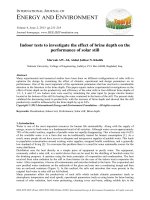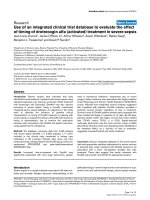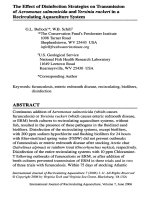To study the effect of seed treatment and foliar nutrition on growth and yield of field pea (Pisum sativum L.) under utera system
Bạn đang xem bản rút gọn của tài liệu. Xem và tải ngay bản đầy đủ của tài liệu tại đây (635.34 KB, 5 trang )
Int.J.Curr.Microbiol.App.Sci (2018) 7(11): 327-331
International Journal of Current Microbiology and Applied Sciences
ISSN: 2319-7706 Volume 7 Number 11 (2018)
Journal homepage:
Original Research Article
/>
To Study the Effect of Seed Treatment and Foliar Nutrition on Growth and
Yield of Field pea (Pisum sativum L.) under Utera System
Tarun*, D.K. Chandrakar and Krishna Kumar
Department of Agronomy, Indira Gandhi Krishi Vishwavidhyalaya, Raipur-492012,
Chhattisgarh, India
*Corresponding author
ABSTRACT
Keywords
Field pea (Pisum
sativum L.), Utera
or paira, Nutrition
Article Info
Accepted:
04 October 2018
Available Online:
10 November 2018
A field experiment was conducted during rabi season of 2017-18 at Instructional cum
Research Farm, Indira Gandhi Krishi Vishvavidhyalaya, Raipur, Chhattisgarh. Utera or
paira cropping (relay cropping) is age old double cropping system under the rainfed
conditions in which succeeding utera crop is directly broadcasted in the standing rice crop
after the flowering stage (Sharma et al., 2004). Fieldpea are a valuable source of protein
for both man and animals. The majority of pea proteins are storage proteins, or globulins,
and the amino acid profile of these proteins determines their nutritional value. The
experiment was laid out in Factorial Randomized Block Design having the combination of
twelve treatments and three replications. The treatment consisted of two seed treatment
and six foliar nutrients spray. Seed treatment, S2: Seed treatment with Rhizobium + PSB +
fungicide + Sodium molybdate @ 0.5 g kg-1 seed recorded higher growth character, yield
attributes and seed yield than with S1: Seed treatment with Rhizobium + PSB + fungicide
under rainfed rice - utera condition. As regards to foliar nutrients F5: 0.5% NPK
(19:19:19) spray at branching and 15 days after 1 st spray was found superior among other
foliar nutrient sprays in respect of growth characters, yield attributes and yield under rain
fed rice - utera system.
Introduction
Utera or paira cropping (relay cropping) is
age old double cropping system under the
rainfed conditions in which succeeding utera
crop is directly broadcasted in the standing
rice crop after the flowering stage (Sharma et
al., 2004). It is prevalent in shallow rainfed
lowland ecosystem of Eastern India. This
system is important for resource poor farmers
as it incurs no expenditure on land preparation
and irrigation. Also, the system improves the
land use efficiency of a vast tract of rice
fallow, smoothers weed, adds organic matter
and nitrogen, especially when pulse crop is
grown. Thus, it entails resource conservation
technologies like zero tillage, no irrigation,
crop diversification with legume, and organic
matter build-up. In recent years, popularity of
field pea as utera crop is increased. Pea starch,
like that of most other starchy pulses, contains
an intermediate level of amylose, which is
reflected in its unique functionality and its
higher levels of enzyme-resistant starch and
slowly digestible starch (as compared with
327
Int.J.Curr.Microbiol.App.Sci (2018) 7(11): 327-331
cereal, root and tuber starches, most of which
are lower in amylose). Protein content in peas
(21.2-32.9%), starch (36.9-49.0%), Amylose
(20.7-33.7%), Total dietary fibre (14-26%),
Insoluble fibre (10-15%), Soluble fibre (29%), Soluble sugars (5.3-8.7%), Total lipid
(1.2-2.4%) and Ash (2.3-3.4%) (Wendy,
2012). Rhizobium inoculation is a significant
technology for the manipulation of rhizobia
for improving crop productivity and soil
fertility. Rhizobium inoculation can lead to
establishment of large rhizobia in the
rhizosphere and improved nodulation and
nitrogen fixation even under adverse soil
conditions (Peoples et al., 1995). In fieldpea
rhizobium inoculation is the process of
applying rhizobium inoculants to the fieldpea
seed before planting in order to increase the
nitrogen fixation and nodulation of the
fieldpea roots. Inoculating fieldpea provides
adequate number of bacteria in the root zone,
so that effective nodulation will take place.
Fieldpea fixes and utilizes the atmospheric
nitrogen in symbiotic association with
Rhizobium leguminosarum bacteria. It also
helps in enriching the N-fertility by decaying
of roots and nodules. Combined application of
Rhizobium and phosphate solubilizing bacteria
have synergistic action and stimulate their
activity, however it is largely depended upon
rhizospheric and climatic conditions.
Materials and Methods
A field experiment was conducted during rabi
season of 2017-18 at Instructional cum
Research Farm, Indira Gandhi Krishi
Vishvavidhyalaya, Raipur, Chhattisgarh. To
find out the effect of seed treatment and foliar
nutrition on growth and yield of fieldpea
under utera system. The soil of the
experimental field was Vertisols with low,
medium and high in N, P and K, respectively
and neutral in reaction. The climate of the
region is sub-humid to semi-arid. The
experiment was laid out in Factorial
Randomized Block Design having the
combination of twelve treatments and three
replications. The treatment consisted of two
seed treatment and six foliar nutrients spray.
The experiment was comprised of factor A.
Seed treatments, S1: Seed treatment with
Rhizobium + PSB + fungicide and S2: Seed
treatment with Rhizobium + PSB + fungicide
+ Sodium molybdate @ 0.5 g kg-1 seed and
factor B. Foliar nutrient spray, F1: Control
(water spray), F2: 2% Neem coated urea spray
at branching, F3: 2% Neem coated urea spray
at branching and 15 days after 1st spray, F4:
0.5% NPK (19:19:19) spray at branching, F5:
0.5% NPK (19:19:19) spray at branching & 15
days after 1st spray, F6: 2 % DAP spray at
branching and 15 days after 1st spray. Fieldpea
(Pisum sativum L.) variety Indira Matar-1 was
sown 18th October, 2017 with a seed rate of
100 kg ha-1. The crop was harvested on 2nd
February 2018 (Fig. 1).
Results and Discussion
Growth character
Significantly taller plant was recorded under
the S2: Seed treatment with Rhizobium + PSB
+ fungicide + Sodium molybdate @ 0.5 g kg-1
seed as compared to S1: Seed treatment with
Rhizobium + PSB + fungicide. During all the
stages of observation except at 30 DAS
whereas, it as found non-significant variation.
Treatment F5: 0.5% NPK (19:19:19) spray at
branching & 15 days after 1st spray gave
significantly highest plant height of fieldpea
and it was at par with F6: 2 % DAP spray at
branching & 15 days after 1st spray except at
30 DAS. The maximum number of branches
plant-1 of fieldpea was recorded under the S2:
Seed treatment with Rhizobium + PSB +
fungicide + Sodium molybdate @ 0.5 g kg-1
seed then S1: Seed treatment with Rhizobium +
PSB + fungicide. Among foliar nutrient
treatment F5: 0.5% NPK (19:19:19) spray at
328
Int.J.Curr.Microbiol.App.Sci (2018) 7(11): 327-331
branching & 15 days after 1st spray, but it was
at par with F6: 2 % DAP spray at branching &
15 days after 1st spray at 60 DAS. Karpagam
et al., (2004) stated that foliar application of
five sprays of NPK 19:19:19 along with the
normal recommended dose recorded the
highest plant height. Khalid et al., (2015)
found that N3P3K3 x foliar nutrition
interaction, resulting in a positive increase in
plant height. Krishnan et al., (2014)
investigated that water soluble fertilizers
(starter and booster) significantly increase the
plant height (100.40 cm) and the number of
branches (23.4). Mamathashree et al., (2016)
reported that foliar spray of 19:19:19 @ 2%
had favorable effect on plant height (185.9cm)
(Table 1).
Fig.1 Experimental field
329
Int.J.Curr.Microbiol.App.Sci (2018) 7(11): 327-331
Table.1 Plant height of fieldpea at various duration as influenced by seed treatment and foliar nutrient spray
Treatment
Plant height (cm)
30 DAS
60 DAS
90 DAS
At harvest
S1: Seed treatment with Rhizobium + PSB + fungicide
16.8
40.5
51.6
59.6
S2: Seed treatment with Rhizobium + PSB + fungicide + Sodium molybdate
17.4
45.7
56.8
64.9
SEm±
0.23
1.45
1.42
1.47
CD (P= 0.05)
NS
4.26
4.16
4.30
F1 : Control (Water spray)
17.2
33.9
44.7
53.2
F2 : 2% Neem coated urea (NCU) spray at branching
16.6
39.8
50.7
59.2
F3 : 2% Neem coated urea (NCU) at branching and 15 days after 1st spray
17.1
44.0
55.3
62.2
F4 : 0.5% NPK (19:19:19) spray at branching
17.7
43.0
54.3
62.3
F5 : 0.5% NPK (19:19:19) spray at branching & 15 days after 1st spray
16.5
51.5
62.6
70.7
F6 : 2 % Diammonium phosphate (DAP) spray at branching & 15 days after
17.5
46.5
57.7
66.0
SEm±
0.40
2.51
2.46
2.54
CD (P= 0.05)
NS
7.37
7.21
7.44
Interaction (S x F)
NS
NS
NS
NS
A. Seed treatments
-1
@ 0.5 g kg seed
B. Foliar nutrients spray
1st spray
330
Int.J.Curr.Microbiol.App.Sci (2018) 7(11): 327-331
and yield of brinjal (Solanum
melongena L.) hybrid COBH-1. South
Indian hort., 52(1-6):139-145.
Khalid, K.A. and Shedeed, M.R. 2015. Effect
of NPK and foliar nutrition on growth,
yield and chemical constituents in
Nigella sativa L. J. Mater. Environ. Sci.,
6(6): 1709-1714.
Krishnan, A., Indiresh K.M. and Anjanappa,
M. 2014. Effect of water soluble
fertilizers on growth and yield of tomato
(Solanum lycopersicum L.). J.of
Tropical Agric., 52(2): 154-157.
Mamathashree, C.M., Patil, M.B., Ashwini
M. and Shilpa, H.D. 2016. Suitable
water soluble fertilizers for increasing
growth parameters of Pigeonpea. Res.
Environ. Life Sci., 9(8): 931-932.
Peoples, M.B., Herridge, D.F. and Ladha, J.K.
1995. Biological nitrogen-fixation: an
efficient source of nitrogen for
sustainable agricultural production.
Plant Soil. 174: 3-28.
Sharma R.S, Chandra D. and Saha S. 2004.
Paira crop management including zero
tillage for crop establishment. In:
Recent advances in rice based farming
systems. (Eds.), 17-19 November, 2004,
Cuttack, Odisha, Central Rice Research
Institute, 149-160.
Yield attributes
Numerically the maximum number of seeds
pod-1 was recorded in treatment S2: Seed
treatment with Rhizobium + PSB + fungicide
+ Sodium molybdate @ 0.5 g kg-1 seed. In
case of foliar nutrient treatment F5: 0.5%
NPK (19:19:19) spray at branching & 15 days
after 1st spray was recorded maximum
number of seeds pod-1 and minimum was
recorded under F1: Control (Water spray).
Treatment S2: Seed treatment with Rhizobium
+ PSB + fungicide + Sodium molybdate @
0.5 g kg-1 seed was found suitable in
enhancing seed yield and Stover yield and
thereby the harvest index. Under foliar
nutrient treatment F5: 0.5% NPK (19:19:19)
spray at branching and 15 days after 1st spray
was found suitable in enhancing seed yield
and Stover yield and thereby the harvest
index, however it was comparable with F6:
2% DAP spray at branching and 15 days after
1st spray and minimum was recorded under
F1: Control (water spray).
References
Karpagam, R., Kannan, M., Natarajan, S. and
Srinivasan, K. 2004. Studies on the
efficacy of foliar feeding of water
soluble fertilizers on growth parameters
How to cite this article:
Tarun, D.K. Chandrakar and Krishna Kumar. 2018. To Study the Effect of Seed Treatment and
Foliar Nutrition on Growth and Yield of Field pea (Pisum sativum L.) under Utera System.
Int.J.Curr.Microbiol.App.Sci. 7(11): 327-331. doi: />
331









